This content is archived from the Feline Nutrition Foundation
Feline Diabetes: The Influence of Diet
- Updated: Saturday, June 01, 2019 05:16 PM
- Published: Wednesday, January 01, 2014 02:40 PM
- Written by Elisa Katz, DVM
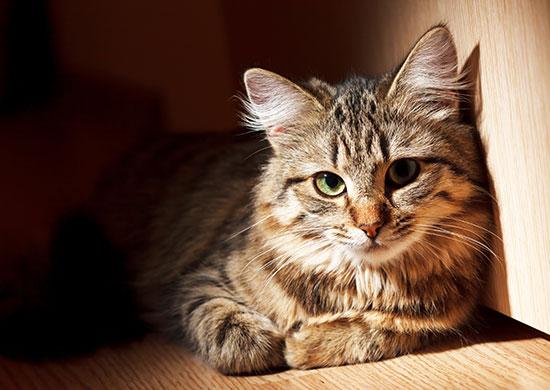 Feline diabetes mellitus is similar to human type II diabetes, also known as non-insulin dependent diabetes. In these patients, the pancreas is able to produce insulin, though it is not enough to adequately control blood sugar. This may be due to damage from inflammation of the pancreas, overwork/exhaustion of the pancreas due to chronically elevated blood sugar and/or if the cells of the body have become somewhat resistant to insulin. Whatever the cause or causes, the end result is the insulin produced by the pancreas is no longer enough to control blood sugar.¹ Glucose is a sugar, so the terms blood glucose and blood sugar are used interchangeably.
Feline diabetes mellitus is similar to human type II diabetes, also known as non-insulin dependent diabetes. In these patients, the pancreas is able to produce insulin, though it is not enough to adequately control blood sugar. This may be due to damage from inflammation of the pancreas, overwork/exhaustion of the pancreas due to chronically elevated blood sugar and/or if the cells of the body have become somewhat resistant to insulin. Whatever the cause or causes, the end result is the insulin produced by the pancreas is no longer enough to control blood sugar.¹ Glucose is a sugar, so the terms blood glucose and blood sugar are used interchangeably.
Certain disease states can contribute to or cause diabetes if they damage the pancreas or cause sustained increases in blood sugar. These conditions include pancreatitis, which is inflammation of the pancreas, hormonal diseases such as hyperthyroidism or hyperadrenocorticism, and persistent infection, such as that from chronic dental infection. Certain pharmaceutical drugs that cause increases in blood glucose, most notably steroids, may also contribute to diabetes in cats.² Lastly, obesity contributes to diabetes. Obesity in cats leads to peripheral insulin resistance. A substance called amyloid which interferes with pancreatic function has also been found to be present in the pancreas of obese cats.³ Certain breeds of cats seem more likely to develop diabetes, primarily Burmese cats.
The more common reasons for obesity and peripheral insulin resistance in cats however, are quite simple. An inappropriately high-carbohydrate diet in an obligate carnivore coupled with low physical activity.⁴ In order to understand how this occurs, we must try to understand the feline, their dietary needs and what their bodies do not need and therefore turn into fat.
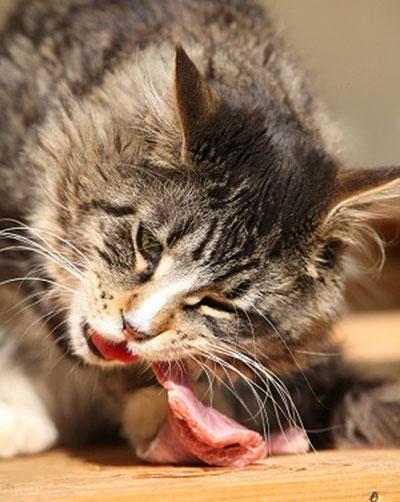 Cats are strict carnivores. This means that they must eat meat as the major portion of their diet. According to Kirk, Debraekeleer, and Armstrong, cats have "unique anatomic, physiologic, metabolic and behavioral adaptations to a strictly carnivorous diet."⁵ The feline is unable to synthesize certain amino acids, primarily taurine, that therefore must be consumed and can only be found in meat. Cats also require certain other amino acids and vitamins that are abundant in animal tissue.⁶ Additionally, unlike many other species, cats break down protein to maintain blood sugar and have a limited ability to use carbohydrates, like starches and sugars, as a source of energy. Hence, they are readily stored as fat.⁷ This is the reason why dry food, which requires a high amount of carbohydrate to achieve the nugget form, likely contributes to obesity and insulin resistance.⁸
Cats are strict carnivores. This means that they must eat meat as the major portion of their diet. According to Kirk, Debraekeleer, and Armstrong, cats have "unique anatomic, physiologic, metabolic and behavioral adaptations to a strictly carnivorous diet."⁵ The feline is unable to synthesize certain amino acids, primarily taurine, that therefore must be consumed and can only be found in meat. Cats also require certain other amino acids and vitamins that are abundant in animal tissue.⁶ Additionally, unlike many other species, cats break down protein to maintain blood sugar and have a limited ability to use carbohydrates, like starches and sugars, as a source of energy. Hence, they are readily stored as fat.⁷ This is the reason why dry food, which requires a high amount of carbohydrate to achieve the nugget form, likely contributes to obesity and insulin resistance.⁸
What happens during diabetes and what are the signs?
The cells of the body require insulin to be able to utilize glucose for energy. When cells cannot use glucose, they essentially starve, which results in muscle loss, weakness, and certain neurologic problems. Additionally, when blood glucose is excessive, it is lost through the kidneys and osmotically takes water with it resulting in increased urination and thirst termed "osmotic diureses."
Signs of diabetes mellitus may include: increased thirst, increased appetite, weight loss, lethargy, change in grooming behavior and/or an unusual hind limb stance called "down in hocks." If you have multiple cats and/or do not observe when your cats drink, you may notice larger clumps in the litter box or more than the usual amount of urine clumps in the litter box.
How is feline diabetes diagnosed?
There are many tests that can be done to help diagnose diabetes mellitus. One of the simpler, easier screening tests is to check the urine for sugar. This can be done by collecting a urine sample from your cat and bringing it to your veterinarian for analysis. Alternatively, a special cat litter additive called Glucotest can be used. Lastly, the cat can be brought to the veterinarian to have a urine sample collected. However, stress can cause a false positive result in this case due to stress hyperglycemia, a blood sugar surge due to a stressful situation. If glucose is detected in the urine, further testing will be needed. The veterinarian will need at least one blood glucose reading if not an entire blood glucose curve as well as a complete CBC and chemistry panel with thyroid levels. This evaluates internal organ function and checks for other possible concurrent conditions such as pancreatitis or hyperthyroidism.
Another useful test in the diagnosis of feline diabetes is a blood test called a fructosamine level. This test measures the average blood glucose value over the previous one to two weeks and therefore is not affected by stress hyperglycemia.⁹
Can cats experience "pre-diabetes" the same way that people do?
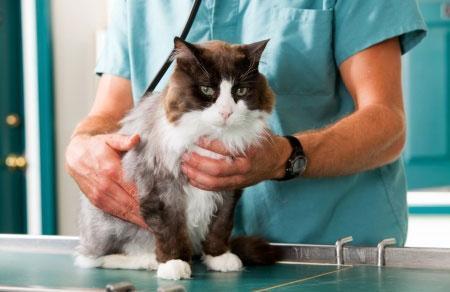 Yes, cats can and do experience a pre-diabetic period, also known as subclinical diabetes, and can also experience a "honeymoon period." The pre-diabetic period is a time during which blood glucose may be mildly increased, but the pancreas is still producing enough insulin to avoid persistent, significant hyperglycemia. Pre-diabetes is most likely to occur in obese cats on a high-carbohydrate, dry food diet. The "honeymoon period," also known as transient diabetes, is a time period during which a previously diagnosed diabetic cat goes into remission and is no longer in need of insulin. This period may be temporary or may be permanent and is highly dependent on the feeding of a proper high protein/low carbohydrate, bio-appropriate diet.¹⁰
Yes, cats can and do experience a pre-diabetic period, also known as subclinical diabetes, and can also experience a "honeymoon period." The pre-diabetic period is a time during which blood glucose may be mildly increased, but the pancreas is still producing enough insulin to avoid persistent, significant hyperglycemia. Pre-diabetes is most likely to occur in obese cats on a high-carbohydrate, dry food diet. The "honeymoon period," also known as transient diabetes, is a time period during which a previously diagnosed diabetic cat goes into remission and is no longer in need of insulin. This period may be temporary or may be permanent and is highly dependent on the feeding of a proper high protein/low carbohydrate, bio-appropriate diet.¹⁰
What are the treatment options for feline diabetes?
Insulin by injection is a requirement for the appropriate treatment of feline diabetes. Insulin is not difficult to administer. The needles are very small and the injection is quick because the amount of insulin is also small. Oral hypoglycemic medications often are not enough to adequately control blood sugar and prevent long-term complications. Additionally, most cats are not amenable to taking twice daily oral medications.¹¹
PZI, protamine zinc insulin, is the most recommended type of insulin. This insulin is the most similar to a cat's natural insulin out of all of the available types. Human recombinant type insulin such as NPH can work for cats, but are not ideal as they differ fairly significantly from a cat's natural insulin. Another type of insulin that is sometimes used is a human synthetic insulin called glargine.
A biologically-appropriate raw cat food diet for our obligate carnivores is an absolute necessity to obtain the best glycemic control, weight control and the best chance of diabetic remission. When fed the proper diet, up to 90% of newly-diagnosed diabetic cats may become non-diabetic and stay that way.¹²
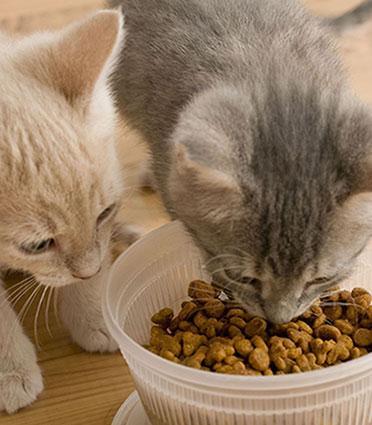 In order to achieve diabetic remission, the cat's diet should have less than 10% of calories from carbohydrate.¹³ This can be achieved with commercial or homemade cat food as well as some higher quality canned diets. Pet food companies intentionally make it confusing for pet owners to obtain information on the carbohydrate content of canned foods, but a helpful chart has this information for many commercial canned foods. High-fiber, low-fat diets, such as some of the older prescription diets recommended by many veterinarians, are not ideal for cats, though some outdated references still recommend them. According to Donald Strombeck, DVM, PhD, "There is no evidence that additional fiber is of any benefit in managing a cat with diabetes mellitus. Cats also do not readily accept a high fiber diet."¹⁴
In order to achieve diabetic remission, the cat's diet should have less than 10% of calories from carbohydrate.¹³ This can be achieved with commercial or homemade cat food as well as some higher quality canned diets. Pet food companies intentionally make it confusing for pet owners to obtain information on the carbohydrate content of canned foods, but a helpful chart has this information for many commercial canned foods. High-fiber, low-fat diets, such as some of the older prescription diets recommended by many veterinarians, are not ideal for cats, though some outdated references still recommend them. According to Donald Strombeck, DVM, PhD, "There is no evidence that additional fiber is of any benefit in managing a cat with diabetes mellitus. Cats also do not readily accept a high fiber diet."¹⁴
If you must switch your cat's food, it must be done gradually by introducing the new food over about two weeks or so to avoid digestive upset. Cats also become very accustomed to whatever type of food they have eaten most of their lives. Therefore, if your cat has been on dry food its entire life, it may be somewhat of a challenge to transition him or her over to a canned diet. It can be done, however. Don't lose hope. You may have to trick your cat a bit initially. When changing diets it is important to ensure that your cat is still eating. While it is okay for a cat to go without eating for 12 hours or maybe even 24 hours, if more time than this passes since a cat has had a meal, they may potentially be in danger. You must never give insulin to a cat that has not eaten without first checking their blood sugar and consulting your veterinarian. Since most diabetic cats are also obese, they may also be in danger of developing something called hepatic lipidosis, a condition in which the liver tissue turns into fat. This dangerous condition may or may not be reversible depending on how advanced it is when treated.
When transitioning from a dry or high-carbohydrate diet to one that is low in carbohydrates it is also extremely important to monitor blood sugar. This is because low carbohydrate diets are known to achieve better blood sugar control and to reduce the needed insulin dose. If blood sugar is not monitored closely, an in insulin overdose and resultant hypoglycemia may occur.¹⁵
What sort of monitoring is required for diabetic cats?
Especially in the early stages of regulation, blood glucose monitoring is crucial. This is ideally done at home where the kitty will be less stressed. Checking blood sugar is very easy and requires very little blood in most cases. A new, veterinary specific glucometer called the Alphatrak is available and uses only 1 microliter of blood which is 1/1000 of a milliliter. This is about 1/10 of a drop of blood. Many progressive veterinarians are now recommending this type of monitoring because of the minimized stress to the patient.
Home monitoring is strongly encouraged as it will result in the best control and highest chance of remission. However, if the cat is not amenable to this or the client is unwilling to measure blood sugar, monitoring can be done in the clinic along with additional fructosamine and urine testing. It should be noted that relying only on in-clinic monitoring results in a lot of guesswork on the part of the veterinarian as to any dosage adjustments.
Monitoring of thirst and urination can also be useful in knowing when the diabetes has become controlled. When blood sugar has returned to normal, the thirst and urination will return to normal as well.
Some of the newer advancements and thoughts regarding diabetes in cats include Dr. Hodgkins' method for tight monitoring and regulation which claims a very high diabetic remission rate. For those unable or unwilling to prick their kitty, a catheter can be implanted beneath the skin that can continuously monitor the blood sugar. The implantation is an anesthetic procedure and this method is more costly than straight at home monitoring.¹⁶ Before starting any protocol please consult with your regular veterinarian.
What are the main concerns and possible complications with a diabetic cat?
Obviously the number one concern is appropriate control of blood sugar. Other concerns include ensuring that your cat is eating, drinking and urinating in appropriate amounts. Weight control is a significant concern, but, if the proper diet is fed in the proper amount, this issue will take care of itself and the cat should achieve normal body weight in the absence of other conditions mentioned above.
Some potential complications of diabetes include diabetic neuropathy, ketoacidosis and hypoglycemia, the latter of which is likely to occur if the cat is going into diabetic remission. Ketoacidosis is a potentially life-threatening complication that occurs when the blood sugar is allowed to remain very high for an extended period of time. Signs of this are lethargy, vomiting, not eating, hiding or not moving. Diabetic neuropathy results in an unusual hind limb gait where the cat leans back on its hocks. This is a long term complication and is not yet fully understood.¹⁷
Take away messages:
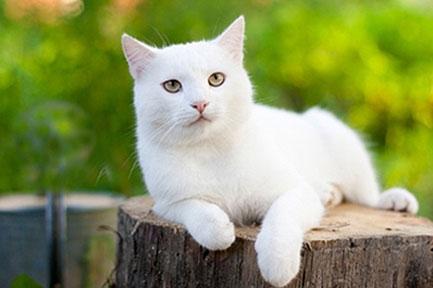 Poor diet and inactivity contribute to obesity and diabetes in our cats. The rate of feline diabetes cases has increased dramatically over the past 40 years in the United States. It has risen from less than 0.2% of cats in the 1970's to between 0.5 – 1.0% today.¹⁸
Poor diet and inactivity contribute to obesity and diabetes in our cats. The rate of feline diabetes cases has increased dramatically over the past 40 years in the United States. It has risen from less than 0.2% of cats in the 1970's to between 0.5 – 1.0% today.¹⁸
The signs of diabetes are easy to recognize if you know what to look for: weight loss despite an increased appetite, increased thirst and increased urination. If you see these in your cat, take him or her to your veterinarian ASAP for examination and testing.
Additional Reading
An Answer For Alex: Raw Food and Tight Regulation
High Blood Pressure: Yes, Your Cat Can Get It, Too
Diagnosing diabetes is relatively straightforward. Most of the time, your veterinarian should be able to tell you right away if your cat is diabetic. Rare instances may occur during the pre-diabetic phase where the results may be questionable.
Diabetes is easily treated and remission is highly likely if three recommendations are followed:
- Insulin must be administered at an appropriate dose,
- Blood glucose must be monitored to help keep it in the normal range,
- The cat must be fed a low-carbohydrate canned diet or another bio-appropriate food, such as a raw cat food diet.
Dr. Elisa Katz, DVM, is a graduate of Ohio State University and is the owner of Natural Pet Animal Hospital in Bourbonnais, Illinois. She practices holistic and integrative medicine focusing on proper diet and nutrition. Dr. Katz shares her home with four kitties and one dog.
The video "Cat Diabetes: How to Monitor Blood Glucose Levels" was provided courtesy of VCA Animal Hospitals.
1. Michael S Hand, DVM, PhD; Craig D Thatcher, DVM, MS, PhD, Rebecca L Remillard, PhD, DVM, and Philip Roudebush, DVM, Small Animal Clinical Nutrition, 4th ed. Walsworth Publishing Company, 2000, 851-852.
2. A Huang, "Feline Diabetes Mellitus," Clinician's Brief 10, no. 10, 2012, 21-24.
3. M Hoenig, "The Cat as a Model for Human Obesity and Diabetes," Journal of Diabetes Science and Technology 6, no. 3, May 2012, 525-533.
4. JS. Rand, LM Fleeman, HA Farrow, DJ Appleton and R Lederer, "Canine and Feline Diabetes Mellitus: Nature or Nurture?" The Journal of Nutrition 134, 2004, 2072S-2080S.
5. Michael S Hand, DVM, PhD; Craig D Thatcher, DVM, MS, PhD, Rebecca L Remillard, PhD, DVM, and Philip Roudebush, DVM, Small Animal Clinical Nutrition, 4th ed. Walsworth Publishing Company, 2000, Chapter 11.
6. D Zoran, "The Carnivore Connection," Journal of the American Veterinary Medical Association 221, no. 11, 2002, 1559-1567.
7. E Kienzle, "Blood Sugar Levels and Renal Sugar Excretion After the Intake of High Carbohydrate Diets in Cats," The Journal of Nutrition 124, 1994, 2563S-2567S.
8. JS Rand, LM Fleeman, HA Farrow, DJ Appleton and R Lederer, "Canine and Feline Diabetes Mellitus: Nature or Nurture?" The Journal of Nutrition 134, 2004, 2072S-2080S.
9. T Lutz, J Rand and E Ryan, "Fructosamine Concentrations in Hyperglycemic Cats," Canadian Veterinary Journal 36, 1995, 155-159.
10. D Zoran, "The Carnivore Connection," Journal of the American Veterinary Medical Association 221, no. 11, 2002, 1559-1567.
11. J Rand and R Marshall, "Advances in Management of Feline Diabetes Mellitus," Proceedings of the North American Veterinary Conference, 2007, 372-374.
12. J Rand, "Feline Diabetes Mellitus: Pathogenesis and Principles of Therapy," Proceedings of the North American Veterinary Conference, 2007, 375-377.
13. L Pierson DVM, "Feeding Your Cat: Know the Basics of Feline Nutrition," 2012.
14. D Strombeck, Home-prepared Dog and Cat Diets, The Healthful Alternative, Iowa State University Press, Ames, IA, 1999.
15. J Rand and R Marshal, "Management of Feline Diabetes Mellitus: Part 2: What Diet Should I Choose and How Do I Manage Problem Cats?," Proceedings of the North American Veterinary Conference, 2007, 381-382.
16. CE Wiedmeyer, PJ Johnson, LA Cohn and RL Meadows, "Evaluation of a Continuous Glucose Monitoring System for Use in Dogs, Cats, and Horses," Journal of the American Veterinary Medical Association 233, no. 7, 2003, 987-992.
17. S Ettinger and E Feldman, Textbook of Veterinary Internal Medicine, 4th Edition, W.B. Saunders Company, Philadelphia, PA, 1995.
18. M Hoenig, "Diabesity," Proceedings of the North American Veterinary Conference, 2007, 366-368.




